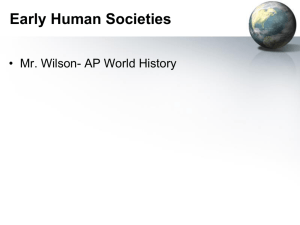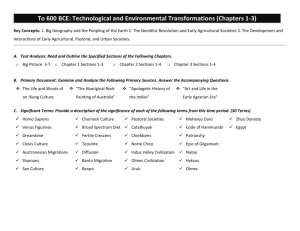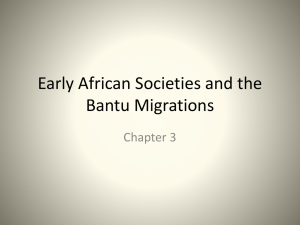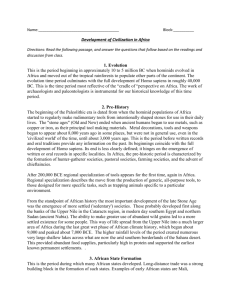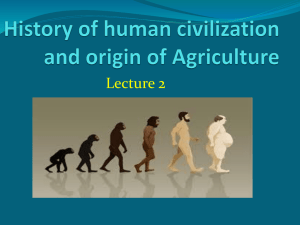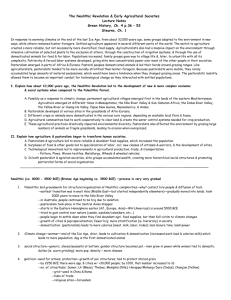power point
advertisement
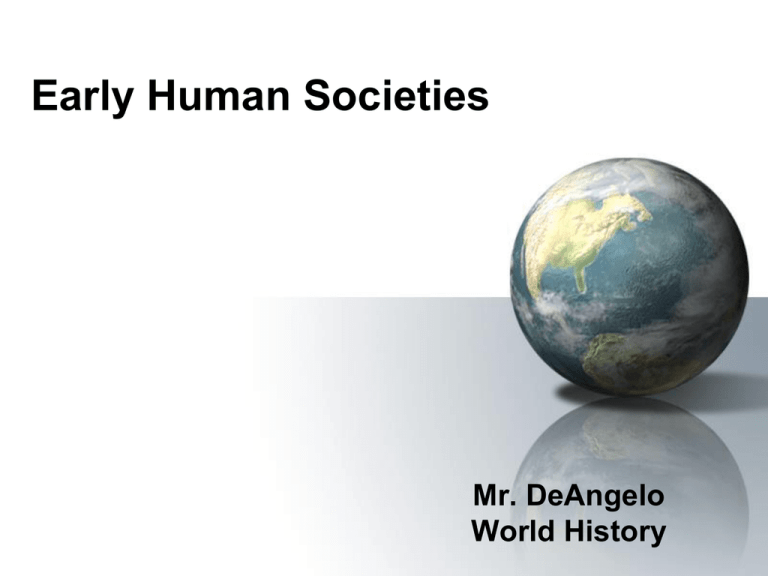
Early Human Societies Mr. DeAngelo World History Paleolithic Age 2 million to 8,000 BCE Focus Question What are the basic characteristics of early human societies? Developments of Paleolithic Age • 100,000 BCE–humans evolved physically and mentally to the level of today – Opposable thumbs & developed brain • Paleolithic Achievements – – – – Invention of tools & weapons Language Control of fire Art (sculpture, jewelry, and cave paintings) • Humans lived in small bands of hunter-gatherers Hunter-Forager Societies • Men hunt and/or fish; women gather fruits, etc. • Lived in kinship groups of 2030 people • Follow migratory patterns of animals • Need large portions of land to support themselves • Life expectancy was 20 years or less Lascaux Cave, France Hunter-Forager Societies • Groups were not always selfsufficient – Trade with neighboring groups was often necessary • Developed tools suitable for their environment • Practiced animism Migration of Humans Focus Question What causes people to migrate? Indo-European Migrations Indo-European Languages Indo-European Language Tree Bantu Migrations (1500 BCE-500 CE) • Bantu people originated in central Africa (Cameroon) • Migration triggered by the drying of the Sahara – Reach South Africa by 300 CE • Introduced agriculture, cattle herding, and iron (?) to SubSaharan Africa • Become dominant ethnic and language group of SubSaharan Africa African Language Distribution Bantu words borrowed by Western culture Banjo Bongos Gumbo Jumbo Safari Conga Rumba Zombie Kwanzaa Polynesian Migrations (3000 BCE -500 CE) Discussion Question What causes technological change? Focus Question What were the effects of the Neolithic Revolution? Neolithic Revolution • Around 10000 BCE, two discoveries revolutionized human society – Farming (1st crops were wheat & barley) – Herding (1st domesticated animals were goats, pigs, & cattle) • Domesticated animals produced a new type of society called Pastoralists • Farming & herding allowed for urban development – 1st cities emerged in Middle East (Turkey & Jordan) – Jericho and Catal Huyuk Origins of Agriculture Pastoral Societies • Nomadic peoples who herd domesticated animals • Move in search of food for their animals – Traditionally more stable than hunter-gatherer societies • Develop on marginal land apart from areas suitable for agriculture, often semi-arid regions – Interact with agricultural societies Pastoral Societies • Many pastoral nomads lived in kin-related bands numbering up to 100 • Tribal membership was defined by recognizing a common ancestry among kinship groups • Often called Courage Cultures – Warlike males bound to each other by ties of personal loyalty tended to dominate these societies – Violence between kinship groups limited the ability of clans and tribes to cooperate • Most practice a form of animism or shamanism Early Villages • Earliest villages located in the Middle East • Population of early villages evolved from the hundreds to the thousands • Probably declined due to environmental degradation Top: Artist rendering of the early village of Catal Huyuk; Bottom: statue of a goddess from Catal Huyuk Life in Early Villages • Full-time political and religious figures emerge as community leaders • Specialized workers such as toolmakers, miners, and merchants • Despite specialization, well-defined social stratification did not exist • Farming & specialization of labor led to a decline in the role of women • Farming & specialized labor led to increase in technology – Pottery, the plow, irrigation, woven textiles, wheeled vehicles World Population Growth Intensive agriculture caused human population to jump from 5-8 million to 60 to 70 million in 5,000 years What are the potential effects of population pressure? World Population Growth Negative Effects of Population Growth Rise of Civilization 4th Millennium BCE • New discoveries transformed permanent settlements into civilizations – Bronze – Writing • First civilization emerged in Mesopotamia (modern day Iraq) c. 3500 BCE
